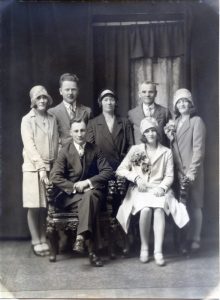About this project
This catalog began as an attempt to sort out the family relationships of my great-grandparents, Joe Bublick and Julia Swedish, after I discovered the name and location of the village where they were born. My primary sources were the birth, death, and marriage records of the former Greek Catholic parish of Męcina Wielka. Many of these record books survived the tumultuous first half of the 20th century, and they (or hand-written copies diligently transcribed by the priests) eventually made their way to the Polish National Archives, where, through the generosity of the Polish government, they have been scanned and made freely available to anyone with Internet access.
Despite being freely available, there is no index, so it is difficult to do genealogical research with them. Some of the records have been indexed on microfilm by the Church of Latter Day Saints (Mormons), but they are incomplete and not online. There is considerable interest in these records by Polish genealogists, and the Polish Genealogical Society has crowd-sourced the indexing of the old church records. I am one of the few people interested in Męcina Wielka, and they accepted the first draft of my index for inclusion in their database. However, their search engine is largely inaccessible to non-Polish-speakers, which is why I am making it available here.
The parish of Męcina Wielka was comprised of four adjacent villages in the northern foothills of the Carpathian Mountains: Męcina Wielka (Macina Velka), Rozdziele (Rozdilja), Wapienne (Vapenne), and Pstrążne (Pstruzhne). Today this region is under Polish administration, but it was not always so. The aftermath of the First World War altered the political map of that part of the world fundamentally, but during the period when the events in these parish registers were recorded, this region was part of the Habsburg crown land of Galicia and Lodomeria, on the north-east fringe of the Austrian Empire. Historically, this region was known as Lemkovyna or Лемківщина, the homeland of the Lemko people, members of the Carpatho-Rusyn ethno-linguistic group.
This map
shows the general area occupied by the parishes of Męcina Wielka, Bednarka, and Pielgrzymka.
Because of the relatively small number of names commonly in use, there is a great deal of duplication of personal names in the database. So far we have recorded 46,967 names in 10,705 records, but not all of these names refer to different people. As individual people are identified and their family relationships are established, we assign them an identification number to help differentiate them and trace their activity across the decades. More details about them can be found by clicking the link in the SNUM (serial number or ID) field, when available. To date, 6,427 individual people have been thus identified.
In the early records, the first (baptismal or "given") names were mostly in Latin. These were the "official" names that people would have used when interacting with Church authorities, but they would have referred to themselves and each other quite differently in the course of daily life. Later on, Rusyn, Ukrainian, and/or Polish equivalents started to be used in the records.
There was a fair bit of latitude in the spelling of surnames. Since most of the people in these villages were illiterate they had to rely on the parish priest for the correct spelling of their name, and the priests' notions of what was "correct" would drift with the passage of time. Women tended to accumulate a multiplicity of names as they outlived their husbands; we frequently see the name of a widow's late husband given instead of her maiden name. Another complicating feature of Carpatho-Rusyn nomenclature is the widespread use of aliases or nicknames by both men and women.
Rather than attempt to standardize the names, we have simply tried to capture what the priests wrote in the metrical registers as accurately as possible.
One thing to note is that prior to 1848, most of these people were serfs, meaning they were bound to the land and were not free to travel without permission. That said, quite a bit of movement from one village to the next is evident in these records, both seasonally and generationally. Because family relationships often went across parish borders, records from neighboring parishes are gradually being added to this database. To see which villages are currently available, click the Browse button.
If you discover errors, or have a special request for a family name you would like to have indexed, please contact the administrator.
You are welcome to download the entire database under a Creative Commons Attribution license, meaning you can use the data for any purpose without restriction, as long as you credit this website as its source.

